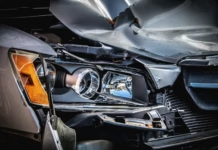The Highway Code states as a driver or a motorcyclist; you must:
- Slow down, and if necessary, stop if you are dazzled by bright sunlight (93)
- Do not use tinted glasses, lenses, or visors if they restrict your vision at night or in poor visibility (94)
You can receive a discretionary disqualification, an unlimited fine and three to nine points on your licence, and this comes under careless and inconsiderate driving.
According to the experts, drivers must consider the type of tint within sunglasses while driving in the car.
Nimmi Mistry, a professional services optician at Vision Direct, explains you should consider various factors when choosing a tint for sunglasses.
She says: “You need to consider the type of tint in your sunglasses, which can be fixed or variable. Fixed tints don’t change following exposure to UV light, but the opposite is correct if you have variable tints.
“When exposed to high levels of UV, the tint within the sunglasses darken but will return to its original state when this level drops. Car windscreens filter UV light, meaning your sunglasses tint may become too dark or light, so you should pick a fixed tint for driving.
“Choose brown or grey tints for your sunglasses, and this ensures that your perception of colour isn’t distorted while helping protect your eyes from potentially harmful UV rays and distracting glare”.
Your Red Car also spoke to Liz Johnson, optometrist, and clinical director at Eyesite Opticians, who agreed with Nimmi. Liz adds that polarised sunglasses are the best option for drivers as they reduce glare from light-reflecting surfaces and provide protection from bright light; this is especially useful on wet roads after a snowfall.
You have options if you drive with prescription glasses already.
Nimmi says if you usually wear prescription glasses to drive, you should take steps to avoid the risk of the sun impairing your vision while driving. You’ll need a separate pair of prescription sunglasses or clip-on lenses you can attach to your usual pair.
Liz explains different tinted sunglasses will give you the fullest coverage as the frames tend to be bigger and have a consistent tint level. Standard Transition lenses don’t tend to fully darken in a car because the windshield blocks the UV light required to activate the lenses.
Medium tint lenses for driving should be a minimum.
Liz states it usually comes down to personal preference, the darkest tint recommended for daytime driving is 85% absorption, and the most popular colours are brown, grey or green. A graduated tint that gets lighter towards the bottom can make looking at the dashboard more comfortable while still protecting your eyes from bright lights.
Nimmi says tinted lenses are graded according to the tint’s density. Due to the light levels inside the car, filter category two lenses which transmit between 18 to 43% of light, are recommended for daytime driving.
| Light Transmission | Category | Use | Limitations |
| 80% to 100% (clear) | 0 | Indoors or overcast day | None |
| 43% to 80% (light tint) | 1 | Low sunlight | Not for night driving |
| 18% to 43% (medium tint) | 2 | Medium sunlight | Not for night driving |
| 8% to 18% (dark tint) | 3 | Bright sunlight | Not for night driving |
| 3% to 8% (very dark tint) | 4 | Exceptionally bright sunlight | Not for night or day driving |
*info from Vision Direct
All sunglasses should have a filter category number by law.
Both optometrists say the CE mark must meet the European Standard BS EN 1836: 2005 by law until January 2025. From January 2025, the CE mark will no longer be recognised and will be replaced with a UKCA mark. The UKCA mark has been in production since January 2021.
Nimmi adds the CE marking indicates complete protection against UVA and UVB rays. By law, all sunglasses should have a filter category number, so you can pick out a road-safe category two lenses by checking the frame or product description if buying online.
For daytime driving, a tint with no more than 85% light absorption is recommended by Liz. Finally, for driving at night, 57% light absorption and Liz recommends talking to your eye care professional as they can advise you on the absorption of your sunglasses.
Denton Brock, Head of Your Red Car, commented:
“As a motorist, keeping up with the Highway Code to avoid fines and penalties is essential. Always take extra caution when purchasing a new pair of sunglasses, and make sure any accessories in your vehicle are law-abiding.”

| [donate]
| Help keep news FREE for our readersSupporting your local community newspaper/online news outlet is crucial now more than ever. If you believe in independent journalism,then consider making a valuable contribution by making a one-time or monthly donation. We operate in rural areas where providing unbiased news can be challenging. |



















